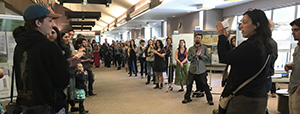Preview

Publication Date
4-26-2016
Abstract
To quantify the effects that wintering Aleutian cackling geese have on agricultural grasslands in Humboldt County, I conducted an experimental study to determine the levels at which grazing and fecal fertilization can both benefit and inhibit the regrowth of ryegrass, a preferred forage species. Results indicated that growth rates are highest at low to moderate levels of grazing, high levels of fertilization, and moderate levels of both grazing and fertilization (1.83g/day). The control, receiving no treatment, yielded the second lowest growth rate (0.78 g/day). I concluded that the combination of herbivory and fecal fertilization at a moderate level is important for plant stimulation, and suggests that a mutualistic relationship exists between Aleutian geese and pasture grass.

